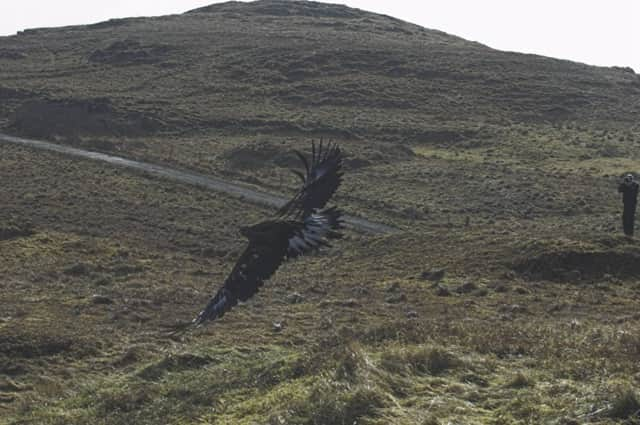Injured golden eagle is first returned to wild


The bird of prey, who has been named Bud, was found with a seriously injured wing last August. He was rescued by a local farmer and handed over to the animal charity Scottish SPCA for specialist care.
Now experts are hopeful the youngster, not yet a year old, has a strong chance of survival.
Advertisement
Hide AdAdvertisement
Hide Ad“Bud is the first ever golden eagle we have been able to release back into the wild and everyone involved is extremely pleased with the outcome,” said Colin Seddon, manager at the charity’s National Wildlife Rescue Centre in Clackmannanshire, where Bud was cared for.
“It is rare for us to rescue golden eagles as there are so few of them in Scotland, and because they tend to live in remote areas they often die before they are found if they become sick or injured.”
Examinations showed the bird had extensive bruising and damage to his flight muscles. Animal medics believe he may have suffered the injuries as a result of being blown against a cliff face or other obstacle during a spate of high winds that blasted the island last summer.
Mr Seddon has put Bud’s recovery down to eight months of dedicated nursing and the expertise of SPCA vets – despite a setback he suffered after breaking a leg in a freak accident at the rescue centre.
In a joint operation between the animal charity and conservationists from RSPB Scotland and Raptor World, the eagle’s homecoming was meticulously planned.
“We had to carefully choose the best time and place to release Bud. It was then a case of waiting for a reasonable weather window,” said Mr Seddon.
We didn’t want to release him in a period of heavy rain as he may not have been able to hunt. We also had to avoid strong winds because, as an inexperienced flyer, Bud would have been blown away from the release site, where food and monitoring is being provided.”
Dave Sexton, Mull officer for RSPB Scotland, said the crippled bird’s rescue had been down to “good fortune” but now he had a second chance.
Advertisement
Hide AdAdvertisement
Hide AdAnd initial signs are encouraging, he said, after the young eagle demonstrated a strong first flight of around 500 metres followed by a graceful landing.
There was also a palpable sense of relief when Bud’s mother and father soared into view and seemed to accept his return.
“It was better he went back to an area where adult birds vaguely knew him rather than going into completely alien territory,” said Mr Sexton.
“He did some very strong, good flights when we let him go. Both parents came up and were aware of him and were not aggressive, so we were pleased.
“I wouldn’t say they flew up to greet him but they could see him and he could see them.
“The last we saw was Bud flying off to where they had gone.”
He added: “You can never be 100 per cent sure how he is going to do but he has had a second chance and so it has been worth all the effort.”
The last national survey, in 2003, identified 440 breeding pairs of golden eagles in Scotland and a solitary male in northern England. A new count is currently under way.
FOLLOW US
SCOTSMAN TABLET AND MOBILE APPS